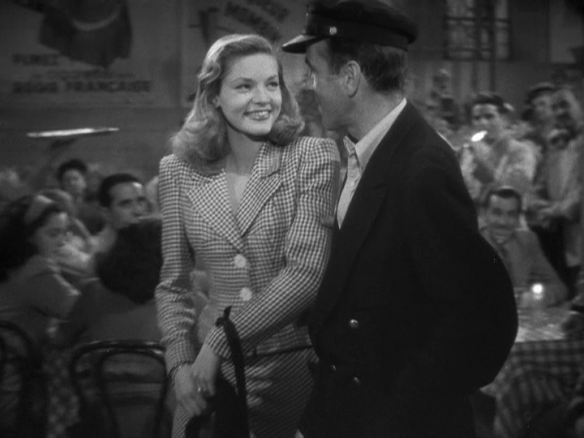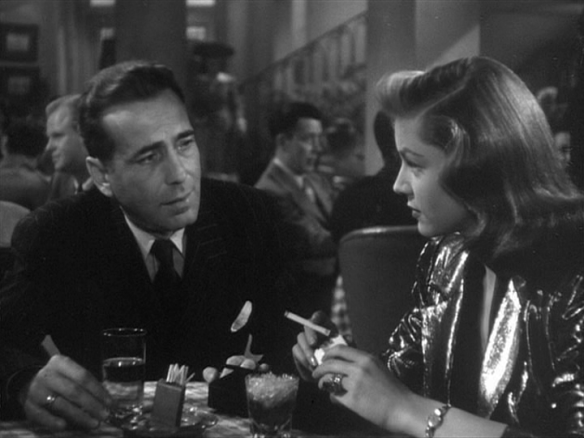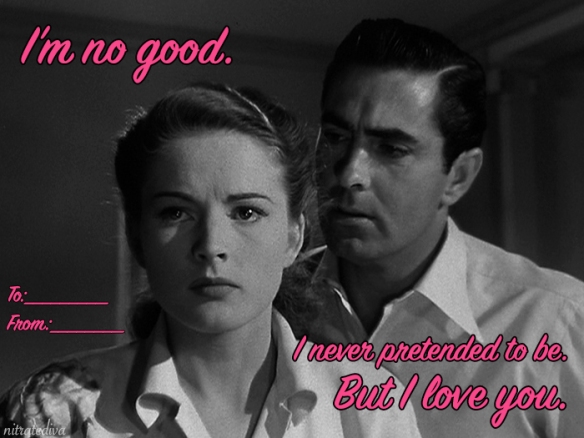 It was hard to believe she had to ask for a match. With those molten eyes, she gave the impression of a woman who didn’t need anybody’s help to ignite.
It was hard to believe she had to ask for a match. With those molten eyes, she gave the impression of a woman who didn’t need anybody’s help to ignite.
Although she made her first movie, To Have and Have Not, at age 19, Bacall didn’t seem to have an ingénue bone in her body. In fact, petrified of the camera, she had to clamp her chin against her shoulder to avoid visibly trembling—and she still exuded maturity and nonchalance.
That famous voice of hers sounded indifferent, bored even, as if she’d burst fully formed from a pulp writer’s head, already fluent in the laconic rhythms of noir dialogue. At Howard Hawks’s urging, she had actually trained herself to talk like that by reading the colossal epic The Robe to herself in a low, husky voice.
The more you listen to her, the more you hear the nuances of desire, humor, fear, and anger, like snippets of a conversation overhead from across a smoke-filled room.
Acting styles can become dated quickly, but Bacall’s best performances remain as subtle and exciting as I imagine they were back in Hollywood’s Golden Age. She’s a puzzle that audiences, as well as her love interests, have a good time trying to figure out. True, she had Hawks’s coaching in the beginning, but the talent and the brains were there. She was a natural-born film actor, the kind that doesn’t let the viewer realize she’s acting.

In the noirish roles for which she is best remembered, Bacall projected her own brand of toughness, distinct from the established paradigms of Crawford’s masochistic bitterness and Stanwyck’s lethal hardness. Instead, she incarnated the perfect feminine counterpart to the hardboiled integrity of protagonists like Philip Marlowe.

Slim in To Have and Have Not can take a slap without flinching. Vivian in The Big Sleep can outwit a vicious gunman at a moment’s notice. Irene in Dark Passage can flirt her way through a police checkpoint with a convict in the backseat of her car. They each pitched an unspoken dare to the world: “You think I’m bluffing? Watch how far I can go.” But whatever made these women so tough left their souls intact. With a spark of unsentimental optimism, they muffled their feelings to survive, but never lost their capacity to feel.
Bacall offered us the joy of a less fatale femme, a dangerous dame who could still believably deliver a happy ending.
 Consider her celebrated “whistle” scene. It’s easy to forget that the scene is really the third scene in a row of just Bogie and Bacall talking in hotel rooms, their characters hesitantly sussing each other out. About eight minutes of such back-and-forth between two other actors might drag in pace. With Bogie and Bacall, it’s so satisfying I want to reach for a cigarette when it’s over. And I don’t even smoke.
Consider her celebrated “whistle” scene. It’s easy to forget that the scene is really the third scene in a row of just Bogie and Bacall talking in hotel rooms, their characters hesitantly sussing each other out. About eight minutes of such back-and-forth between two other actors might drag in pace. With Bogie and Bacall, it’s so satisfying I want to reach for a cigarette when it’s over. And I don’t even smoke.

No wonder a cartoon short of the era, “Bacall to Arms”, lovingly parodied the onscreen sizzle of her debut. As she saunters across a room, an animated trail of flames spurts up from her footprints.

Now, To Have and Have Not doesn’t count as a film noir in my book, but its key relationship scenes undeniably channel a noirish vibe with the low-key lighting, the shuttered windows, and the characters’ ambiguous morals. And Bogie fans then as well as now would have recognized his line to Slim, “You’re good. You’re awful good”, as a clear echo of Sam Spade’s mocking admiration of Brigid’s shtick in The Maltese Falcon.

However, the chemistry in To Have and Have Not promises a more auspicious ending for Slim and Steve than for your typical noir couple. In By Myself, Bacall remembered that, when her family went to see To Have and Have Not, they expressed their relief at the humor in her performance, which lightened some of the sexier elements in the script. Audiences could read the melancholy in her eyes when Steve leans in to examine her face—but they also could hear the note of knowing amusement in her voice as she switches to vampy innuendo. Because Bacall neither plays the role entirely straight, nor burlesques it, she maintains a reassuring aura of decency. Bacall interprets Slim as a good bad girl, daring Steve to take a chance on her. Unsurprisingly, he does.

The frisson of true love blesses To Have and Have Not with an eternal ability to cheer up its spectators (me, for one). Seriously, who doesn’t get a kick out of watching two of the most badass people ever make googly eyes at each other? In the final scene, Bacall wiggles off into the sunset, while even the extra sitting at the table closest to her can’t repress a facial expression that says, “Aw, isn’t that sweet?” As Bogie grabs her by the arm, Bacall smiles her only broad grin of the movie, the toughness slips away, and she looks, for the first time, like a teenager in love.

The Big Sleep challenged Bacall with a more complex role. In contrast to Slim, Vivian Rutledge really is reclining on the razor’s edge, navigating a depraved world to protect her sister. Despite the crackle of her chemistry with Bogie, Bacall dials back the likability she displayed in her debut in favor of a high-hat condescension that masks longstanding worries. For example, keep an eye out for a split-second look of uppity pleasure when Marlowe asks, “They? Who’s they?” in their first scene together. It’s the face of a woman frantically trying to convince herself that she has the situation under control, that she can outwit or seduce any obstacle that crosses her path.

Bacall emphasizes Vivian’s spoiled haughtiness, while hinting at the undercurrent of fear that drives her. This is a woman who refuses to admit that she’s in over her head almost until it’s too late. A woman who’ll chide a man with a loaded gun to prove how tough she is to Marlowe. In Chandler’s novel, none of the Sternwoods deserves redemption, but in the film, the whole clan pulls through. Both censorship and Howard Hawks’s worldview motivated these changes to the original, but it’s Bacall who makes us buy a conclusion that could’ve seemed too neat for a messy plot.

The audience can detect two sides to Bacall’s Vivian: the conniving society brat and the wisecracking dame in distress. Something about the honest mirth of those long takes in Marlowe’s office suggest that the latter is probably the truest side. As she tempts him with a brace of horsey innuendos a few scenes later, Bacall doesn’t hide the fact that Vivian is manipulating Marlowe, but the gusto and wit with which she speaks her lines points to the real Vivian buried under so many lies.
 Ultimately, she proves her mettle by saving Marlowe’s life, leading the killer Canino astray. Her grace under pressure prompts even the jaded P.I. to admit, “I didn’t know they made ‘em like that anymore.” We get the idea that Vivian would always keep Marlowe guessing. Still, he might want to spend the rest of his days guessing about her.
Ultimately, she proves her mettle by saving Marlowe’s life, leading the killer Canino astray. Her grace under pressure prompts even the jaded P.I. to admit, “I didn’t know they made ‘em like that anymore.” We get the idea that Vivian would always keep Marlowe guessing. Still, he might want to spend the rest of his days guessing about her.
 Directed by Delmer Daves, Dark Passage showcased Bacall’s talent for passing off improbable circumstances as natural and credible. Interacting with the first-person camera as though it were Bogie, her character helps a convicted killer, whom she’d never met before, elude the law when he escapes from prison. Who is she? Why is she helping this alleged murderer? Bacall adds to the suspense with her impassive determination, punctuated by discreet glints of anxiety.
Directed by Delmer Daves, Dark Passage showcased Bacall’s talent for passing off improbable circumstances as natural and credible. Interacting with the first-person camera as though it were Bogie, her character helps a convicted killer, whom she’d never met before, elude the law when he escapes from prison. Who is she? Why is she helping this alleged murderer? Bacall adds to the suspense with her impassive determination, punctuated by discreet glints of anxiety.

The romance that blossoms between Bacall and Bogie in Dark Passage would’ve struck the audience as inevitable by this point, and the pair wisely underplay the growing attachment between their characters. Caught in the gaze of the camera-as-Bogie, she occasionally thaws with an unguarded smile. Given her face, that’s enough. Once the camera is freed from its first-person mode, Bacall sustains the almost unbearable tension as she removes the bandages from Bogie’s mug, remodeled by plastic surgery.

In another splendid scene, she rechristens Bogie’s character with an alias, obstinately attempting to focus on the new name instead of the reality that she might be saying goodbye forever. Of her four movies with Bogie, Dark Passage gets short shrift, so, if you haven’t done so already, watch it and be amazed.

Bacall possessed a wide range. In Key Largo, though co-starred again with Bogie, she essayed an unusually demure, vulnerable character. Over the course of her career, she played everything from murderesses to abused wives to spunky gold-diggers. But she was at her most iconic as the good bad girl, the woman fit to accompany Bogie down the mean streets of noir as his equal.

She convincingly portrayed women who lived by their own terms, fought their own battles, and only bared their emotions at the right time to the right man. For a generation of American women who’d done men’s jobs during WWII, Bacall’s performances suggested that toughness and willpower weren’t flaws or signs of ruthlessness, but virtues. In the noirish parts that made her a legend, she was a woman of substance: smart, mysterious, brave, and, above all, fun to watch. And she always will be.

 Philip Marlowe striking a match on Cupid’s stony butt cheeks in Murder, My Sweet rather neatly sums up film noir’s irreverence towards the more delicate notions of love. Go home, arrow boy. You’d better come packing heavier artillery in this part of cinema.
Philip Marlowe striking a match on Cupid’s stony butt cheeks in Murder, My Sweet rather neatly sums up film noir’s irreverence towards the more delicate notions of love. Go home, arrow boy. You’d better come packing heavier artillery in this part of cinema.




















 It was hard to believe she had to ask for a match. With those molten eyes, she gave the impression of a woman who didn’t need anybody’s help to ignite.
It was hard to believe she had to ask for a match. With those molten eyes, she gave the impression of a woman who didn’t need anybody’s help to ignite.

 Consider her celebrated “whistle” scene. It’s easy to forget that the scene is really the third scene in a row of just Bogie and Bacall talking in hotel rooms, their characters hesitantly sussing each other out. About eight minutes of such back-and-forth between two other actors might drag in pace. With Bogie and Bacall, it’s so satisfying I want to reach for a cigarette when it’s over. And I don’t even smoke.
Consider her celebrated “whistle” scene. It’s easy to forget that the scene is really the third scene in a row of just Bogie and Bacall talking in hotel rooms, their characters hesitantly sussing each other out. About eight minutes of such back-and-forth between two other actors might drag in pace. With Bogie and Bacall, it’s so satisfying I want to reach for a cigarette when it’s over. And I don’t even smoke.






 Ultimately, she proves her mettle by saving Marlowe’s life, leading the killer Canino astray. Her grace under pressure prompts even the jaded P.I. to admit, “I didn’t know they made ‘em like that anymore.” We get the idea that Vivian would always keep Marlowe guessing. Still, he might want to spend the rest of his days guessing about her.
Ultimately, she proves her mettle by saving Marlowe’s life, leading the killer Canino astray. Her grace under pressure prompts even the jaded P.I. to admit, “I didn’t know they made ‘em like that anymore.” We get the idea that Vivian would always keep Marlowe guessing. Still, he might want to spend the rest of his days guessing about her. Directed by Delmer Daves, Dark Passage showcased Bacall’s talent for passing off improbable circumstances as natural and credible. Interacting with the first-person camera as though it were Bogie, her character helps a convicted killer, whom she’d never met before, elude the law when he escapes from prison. Who is she? Why is she helping this alleged murderer? Bacall adds to the suspense with her impassive determination, punctuated by discreet glints of anxiety.
Directed by Delmer Daves, Dark Passage showcased Bacall’s talent for passing off improbable circumstances as natural and credible. Interacting with the first-person camera as though it were Bogie, her character helps a convicted killer, whom she’d never met before, elude the law when he escapes from prison. Who is she? Why is she helping this alleged murderer? Bacall adds to the suspense with her impassive determination, punctuated by discreet glints of anxiety.



